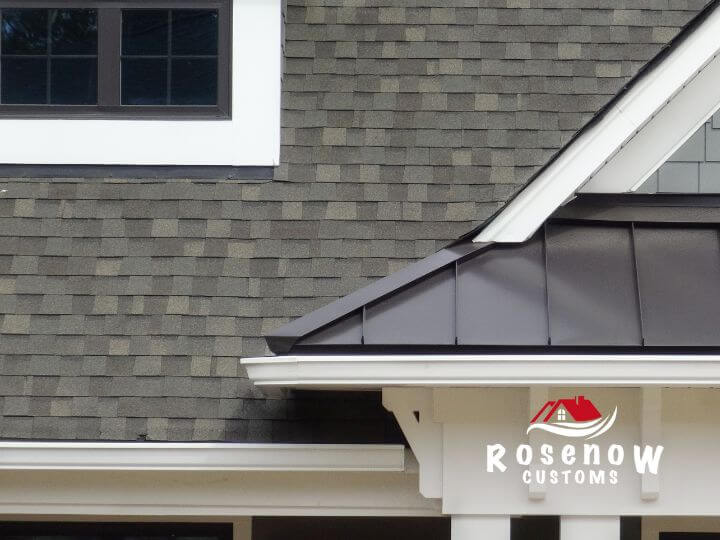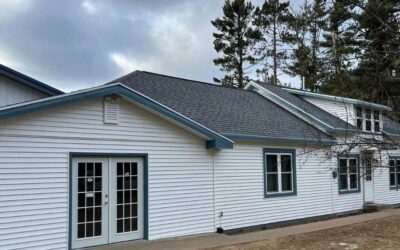Roof inspections are a critical aspect of home maintenance that should not be overlooked. This essential procedure can help identify potential issues before they escalate into costly repairs or replacements. With Rosenow Customs offering expert roof maintenance services, homeowners can rest easy knowing they’re in good hands. Preparing for a roof inspection may seem daunting, but with the right guidance, you can navigate this process with ease. This article will provide you with comprehensive information on how to prepare for a roof inspection, from understanding its importance to selecting a trustworthy professional, and what to expect during and after the inspection.
Understanding the Role of Roof Inspections
A roof inspection is akin to a comprehensive health checkup for your home’s topmost shield. It’s a systematic process that uncovers minor issues before they morph into significant, costly repairs. By identifying potential weaknesses, signs of wear and tear, or damage, a roof inspection can help avert major housing problems down the line.
When conducted by a seasoned professional, a roof inspection can reveal a host of issues. These may include leaks, rot, structural damage, or problems with shingles, tiles, or other roofing materials. The inspection also encompasses pipes, chimneys, vents, and any other equipment installed on or passing through your roof. Grasping the importance of regular roof inspections can empower you to take a proactive approach in preserving your home’s structural integrity, preventing serious damages, and promoting overall house health.
The Significance of Routine Roof Inspections
The roof, constantly exposed to harsh weather conditions and environmental elements, is a critical component of your property’s overall health and longevity. Over time, this exposure can take a toll, potentially leading to structural issues if not addressed promptly. This is where the value of routine roof inspections comes into sharp focus.
Think of routine roof inspections as an essential tool in your preventive maintenance arsenal. They can pinpoint minor areas of wear and tear or defects that, if left unnoticed or untreated, could snowball into severe problems. These could range from water intrusion and mold growth to insulation issues, damaged or missing shingles, and structural instability. Each of these issues can undermine the integrity of your roof and, by extension, your property’s value.
Routine roof inspections also play a pivotal role in monitoring your roof’s age and overall condition. Armed with this knowledge, you can plan for roof replacement proactively, steering clear of crisis management and expensive emergency roof repairs.
Additionally, many home insurance policies mandate regular roof inspections. Neglecting these routine inspections could potentially jeopardize your home insurance coverage for any roof damage.
In essence, regular roof inspections offer invaluable insights into your roof’s condition. These assessments not only help maintain your roof in peak condition but also save you considerable time, money, and stress by nipping minor issues in the bud before they escalate.
Steps to Prep Your Home for a Roof Inspection
Proper preparation is the cornerstone of a successful roof inspection. By taking a few strategic steps before the inspector arrives, you can facilitate a more efficient and thorough evaluation of your roof’s condition. This involves readying both the interior and exterior of your home to accommodate the inspection process.
In this section, we’ll provide a comprehensive guide on how to prepare your home for the inspection. This will not only streamline the process but also ensure the most accurate identification of potential roofing issues. A well-prepared home allows for a more detailed inspection, which is crucial for maintaining the safety and longevity of your home.
In the upcoming subsections, we’ll delve into the specifics of preparing your home’s interior and exterior, setting the stage for a smooth and productive roof inspection.
Prepping Your Home’s Interior
While it might seem surprising, readying your home’s interior is a vital component of roof inspection preparation. Though the majority of the inspector’s time will be spent examining the exterior, certain roofing issues can only be detected from inside the house. Here’s how to get your home’s interior ready:
1. De-clutter Attic Spaces: The attic or crawl space is often the first place an inspector will look for signs of leaks, moisture, and insulation issues. Make sure the path to your attic is unobstructed.
2. Secure Delicate Items: Inspectors may need to walk on the roof, which could cause vibrations inside the house. To prevent any damage, pack away fragile and valuable items, particularly those near the roof-connected walls.
3. Safeguard Pets: To prevent any interruptions during the inspection, keep your pets in a secure location. The inspector will need to move freely around your property, which could provide an escape route for adventurous pets.
4. Ensure Access to All Areas: The inspector may need to access all parts of your house. Ensure all doors, especially those leading to the roof or attic spaces, are unlocked and accessible.
5. Illuminate Dark Spaces: A well-lit area makes it easier for an inspector to identify potential issues. Make sure every space in your house is adequately lit.
These steps, while seemingly minor, play a significant role in ensuring a comprehensive and successful roof inspection. The aim is to create a conducive environment for the roof inspector to effectively identify any potential problems, both inside and outside your home.
Preparing Your Home’s Exterior
The exterior of your home plays a pivotal role in the roof inspection process. A well-prepared exterior can significantly streamline the inspection, ensuring a thorough and efficient examination. Here’s a step-by-step guide to ready your home’s exterior for the inspection:
1. Clear the Perimeter: Start by removing any potential obstructions around your home, such as vehicles, outdoor furniture, or children’s toys. This will give the inspector unrestricted access to all sides of your house.
2. Trim Overhanging Branches: Overhanging tree limbs can hinder the inspection process and potentially damage your home. Trim these branches to facilitate a smoother inspection.
3. Clean Gutters and Drains: A clean gutter system can provide valuable insights into your roof’s condition. Ensure your gutters and downspouts are free of blockages before the inspection.
4. Remove Debris from the Roof: Clear any debris, like leaves or twigs, from your roof. This will expose any underlying issues and allow for a more accurate assessment.
5. Secure Pets: If you have pets that spend time outdoors, make sure they are safely contained to avoid any distractions or mishaps during the inspection.
6. Provide Access to the Roof: If your roof requires a ladder for access, ensure you have one that’s sturdy and suitable for the task. If not, inform the inspector in advance so they can bring their own.
The ultimate aim is to provide the inspector with unhindered access to your roof, enabling a comprehensive and effective inspection.
Selecting a Trustworthy Roofing Professional
The choice of a roofing professional is as crucial as the inspection itself. A proficient inspector can extend your roof’s lifespan and save you money over time. But how do you identify a reliable roofing professional?
The answer lies in two critical factors: credentials and experience. These elements are vital in ensuring a thorough and accurate inspection. In the following sections, we’ll delve into these aspects, equipping you with the necessary knowledge to make an informed decision when hiring a roof inspector.
Evaluating a Roof Inspector’s Credentials
Choosing the right roofing professional is a crucial decision, and their credentials play a significant role in this process. Here are some key factors to consider:
Licensure and Certification: It’s essential to verify that the inspector holds a valid license in your state to conduct roof inspections. Certifications from recognized industry associations, such as the International Association of Certified Home Inspectors (InterNACHI) or the National Roof Certification and Inspection Association (NRCIA), further underscore their commitment to professionalism and industry standards.
Insurance: It’s crucial to ensure that your chosen professional carries sufficient insurance for liability and worker’s compensation. This safeguards you from potential legal and financial complications that could arise from any damage or accidents during the inspection.
Bonded: Opting for a bonded inspector provides an additional layer of financial security. Should the inspector fail to fulfill certain obligations, the bond company covers the damages.
Special Training: While not a strict requirement, special training in areas such as safety protocols, advanced inspection techniques, and current building codes can be a valuable asset.
By diligently evaluating an inspector’s credentials, you can rest assured that a competent professional is handling your roof inspection.
Assessing the Inspector’s Experience and Reputation
Beyond credentials, an inspector’s experience and reputation significantly influence their ability to deliver a comprehensive and accurate roof inspection. Here are some aspects to consider:
Years of Experience: The inspector’s tenure in the field can be a good indicator of their understanding of various roofing systems and potential issues. More experience generally equates to a broader knowledge base.
Expertise in Specific Roof Types: It’s important to ensure that the inspector is well-versed with your specific type of roof. An expert in your roof material can more effectively identify potential problems and recommend appropriate solutions.
Positive Client Reviews: Online reviews and client testimonials can provide valuable insights into the inspector’s performance and customer service. A history of satisfied clients often points to a professional who conducts thorough inspections.
Professional References: A reputable roof inspector should be able to provide references from other professionals within the roofing or home service industry. These references can attest to the inspector’s quality of work.
Inspection Report Sample: Requesting a sample inspection report can give you a sense of the inspector’s thoroughness and the types of issues they typically identify.
By carefully assessing a roofing inspector’s experience and reputation, you can ensure you select a professional who will provide an accurate and detailed assessment of your roof’s condition.
What to Anticipate During Your Roof Inspection
Entering a roof inspection with a clear understanding of what to expect can alleviate potential anxiety and allow you to fully leverage the benefits of this crucial process. As a homeowner, your knowledge and preparedness can play a significant role in ensuring a comprehensive and efficient inspection.
The inspection process primarily focuses on two aspects: the inspection itself and the minimization of disruptions during the inspection. Familiarizing yourself with these elements will equip you with the necessary tools to prepare for the inspection. Moreover, understanding how to limit disruptions will contribute to a seamless and productive inspection.
In the following subsections, we will delve deeper into these aspects, providing you with a comprehensive guide on what to anticipate during your roof inspection.
The Inspection Process
The process of a roof inspection involves a meticulous visual and physical assessment of your roof’s interior and exterior. Here’s a step-by-step guide to what this process entails:
1. Exterior Inspection: The inspection kicks off with a thorough evaluation of your roof’s exterior. The inspector will look for signs of deterioration, such as loose or missing shingles, damaged flashing, and compromised seals around vents and chimneys. They will also assess the condition of your gutters and the overall structure of your roof.
2. Interior Inspection: Following the exterior assessment, the inspector will move on to the interior part of your roof, typically accessed through your attic. Here, they will look for signs of leaks, such as water stains or mildew, assess the level of insulation, and check for adequate ventilation.
3. Documentation: A professional inspector will meticulously document their findings, using notes and photographs. This documentation will be used to create a comprehensive inspection report that outlines both minor and major issues, along with recommended solutions.
4. Consultation: A trustworthy inspector will conclude the inspection by discussing their findings with you. They will explain any identified issues in detail and provide advice on the best course of action. This is your chance to ask any questions and address any concerns you may have.
By understanding the inspection process, you can better prepare for it and ensure you get the most out of your roof inspection.
Minimizing Inspection Disruptions
While roof inspections are a crucial part of maintaining your home’s health, they can sometimes lead to minor inconveniences. However, with a few strategic steps, you can significantly reduce these disruptions and ensure a smooth inspection process.
1. Plan Your Day Accordingly: By dedicating a specific time slot for the roof inspection, you can be readily available to address any questions or concerns the inspector might have, thereby facilitating a more efficient process.
2. Facilitate Easy Access: An unobstructed path to your roof and attic is essential. By removing any potential obstacles or debris, you not only expedite the inspection but also enhance the safety of the inspector.
3. Ensure Safety of Children and Pets: It’s crucial to keep your young ones and furry friends away from the inspection site. This precautionary measure helps avoid any potential injuries and keeps the inspection process interruption-free.
4. Maintain Open Communication: A candid conversation with the inspector about any specific concerns or previous issues with your roof can help tailor the inspection to your needs, making it more targeted and effective.
By adopting these strategies, you can ensure that your roof inspection is not only thorough and secure but also minimally disruptive to your daily routine.
Post-Inspection Actions
Once your roof inspection is complete, there are a few important steps to take to fully leverage the benefits of the process. These steps primarily revolve around comprehending the inspection report and planning subsequent roof maintenance based on the expert advice provided. By gaining a solid understanding of these elements, you can significantly enhance the longevity of your roof and safeguard your property investment.
In the subsequent sections, we will delve into how to interpret the inspector’s report and how to plan and implement effective roof maintenance post-inspection.
Understanding the Inspector’s Report
Upon the completion of your roof inspection, you’ll receive a comprehensive report from the inspector. This document is a roadmap to your roof’s current condition and future needs. Let’s break down what you’ll typically find in this report:
1. Comprehensive Analysis: The report will provide an in-depth overview of your roof’s status, pinpointing both minor and significant concerns. This could include everything from leaks and structural damage to general wear and potential vulnerabilities.
2. Visual Aids: To help you better understand the findings, the report often includes visual aids such as photographs or diagrams. These images offer a clear depiction of the issues at hand and give you a holistic view of your roof’s condition.
3. Expert Recommendations: The inspector will also provide their professional advice on how to address the issues identified. This could range from DIY fixes for minor problems to hiring professionals for more complex repairs.
4. Cost Projections: Some reports may include an estimated cost for the suggested repairs or replacements. This information is invaluable in helping you budget for the necessary maintenance.
By carefully reviewing and understanding your roof inspection report, you can make informed decisions about the necessary steps to maintain your roof’s health and longevity.
Roof Maintenance After Inspection
The insights gained from your roof inspection are invaluable, but it’s the actions you take post-inspection that truly make a difference. Here’s how to ensure your roof remains in top condition following the inspection:
1. Regular Check-ups: Scheduling routine inspections as recommended by your inspector is key to catching and addressing potential issues before they escalate.
2. Timely Repairs: Act swiftly on the urgent issues identified in the inspector’s report to prevent them from worsening. This could mean tackling minor repairs yourself or calling in professionals for more significant problems.
3. Consistent Upkeep: Regular maintenance tasks like cleaning gutters, inspecting for loose shingles, or trimming overhanging branches can extend your roof’s lifespan and stave off costly repairs.
4. Financial Planning: Use the cost estimates in the inspector’s report to plan your budget for necessary repairs, replacements, and ongoing maintenance.
5. Insurance Coordination: If your roof has sustained severe damage that’s covered by your home insurance policy, file a claim as soon as possible. Provide your insurer with a copy of the inspection report as evidence.
By adhering to these post-inspection maintenance practices, you can ensure your roof remains in optimal condition, ultimately saving you money and safeguarding your home.
1. What is the significance of preparing for a roof inspection?
Preparing for a roof inspection can help to identify potential issues in advance and allow for peace of mind. A properly executed inspection may spot problems ranging from minor leaks to major structural damage.
2. What preliminary steps should be taken before a roof inspection?
Before a roof inspection occurs, the areas around the house should be clean and accessible to the inspector. Move any vehicles or other obstructions to ensure the entire roofline is visible.
3. Can homeowners conduct a roof inspection independently?
Homeowners can perform preliminary inspections, but professionals have the tools and knowledge to identify and diagnose issues that may be overlooked by untrained individuals.
4. What component areas are critical during a roof inspection?
A professional inspector will examine the roof’s structural integrity, interior and exterior, condition of shingles, and checks for leaks, water damage, mold, or infestations.
5. How frequently should homeowners schedule a roof inspection?
Professionals recommend scheduling a roof inspection at least once every two years. This frequency may increase based on the age, condition, and exposure to severe weather conditions of the roof.
6. What documentation should be expected following a roof inspection?
After a roof inspection, homeowners should obtain a full report detailing the roof’s condition, potential issues, and recommended repairs or maintenance. This document is essential for tracking the roof’s health over time.





